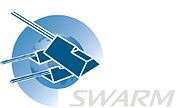Swarm (spacecraft)
 Artist's view of the three Swarm spacecraft | |
| Mission type | Earth's magnetic field observation |
|---|---|
| Operator | ESA |
| COSPAR ID |
SWARM A: 2013-067B SWARM B: 2013-067A SWARM C: 2013-067C |
| SATCAT № |
SWARM A: 39452 SWARM B: 39451 SWARM C: 39453 |
| Website | eoPortal - SWARM |
| Mission duration | 4 years (planned) |
| Spacecraft properties | |
| Manufacturer | Astrium |
| Launch mass | 468 kilograms (1,032 lb) |
| Dry mass | 369 kilograms (814 lb) |
| Dimensions | 9.1 m × 1.5 m × 0.85 m |
| Power | 608 watts |
| Start of mission | |
| Launch date |
22 November 2013, 12:02:29 UTC |
| Rocket | Rokot/Briz-KM |
| Launch site | Plesetsk Site 133/3 |
| Contractor | Eurockot |
| Orbital parameters | |
| Reference system | Geocentric |
| Regime | Polar orbit |
| Perigee |
SWARM A: ≤460 km (290 mi) SWARM C: ≤460 km (290 mi) SWARM B: ≤530 km (330 mi) |
| Apogee |
SWARM A: ≤460 km (290 mi) SWARM C: ≤460 km (290 mi) SWARM B: ≤530 km (330 mi) |
| Inclination |
SWARM A: 87.4° SWARM C: 87.4° SWARM B: 88° |
| Mean motion | 15 |
| Epoch | Planned |
| Transponders | |
| Band | S Band |
| Frequency | 2 GHz |
| Bandwidth |
6Mbit/s download 4kbit/s upload |
| Instruments | |
|
VFM: Vector Field Magnetometer ASM: Absolute Scalar Magnetometer EFI: Electric Field Instrument ACC: Accelerometer LRR: Laser Range Reflector | |
 Living Planet Programme | |
Swarm is an European Space Agency (ESA) mission to study the Earth's magnetic field. High-precision and high-resolution measurements of the strength, direction and variations of the Earth's magnetic field, complemented by precise navigation, accelerometer and electric field measurements, will provide data essential for modelling the geomagnetic field and its interaction with other physical aspects of the Earth system. The results will offer a unique view of the inside of the Earth from space, enabling the composition and processes of the interior to be studied in detail and increase our knowledge of atmospheric processes and ocean circulation patterns that affect climate and weather.
Overview
The overall objective of the Swarm mission is to build on the experience from the Ørsted and CHAMP missions and to provide the best ever survey of the geomagnetic field (multi-point measurements) and its temporal evolution, to gain new insights into the Earth system by improving our understanding of the Earth's interior and climate.[1]
The Swarm constellation consists of three satellites (Alpha, Bravo & Charlie) placed in two different polar orbits, two flying side by side at an altitude of 450 km (280 mi) and a third at an altitude of 530 km (330 mi).[1][2] The launch was delayed and rescheduled to 12:02:29 UTC (7:02:29 a.m. EST) on 22 November 2013, from Plesetsk Cosmodrome, Russia.[3] ESA contracted Astrium to develop and build the three orbiters,[1] while Eurockot provided the launch services.[4]
Scientific objectives
Primary objectives:
- Earth core dynamics, geodynamo processes, and core-mantle interaction
- Lithospheric magnetization and its geological interpretation
- 3D electrical conductivity of the mantle
- Currents flowing in the magnetosphere and ionosphere
Secondary objectives:
- Identification of the ocean circulation by its magnetic signature
- Quantification of the magnetic forcing of the upper atmosphere
Payload
The payload of the three spacecraft consists of the following instruments:[2]
- Vector Field Magnetometer (VFM): Linear and low-noise measurements of the Earth's magnetic field vector components. The fluxgate vector magnetometer is similar to the ones in the satellites Ørsted, CHAMP and SAC-C.
- Absolute Scalar Magnetometer (ASM): Calibration of the main instrument VFM.
- Electric Field Instrument (EFI): Measurement of ion density, drift velocity and electric field.
- Accelerometer (ACC): Measurement of non-gravitational accelerations like air-drag, winds, Earth albedo and solar radiation pressure.
- Laser Range Reflector (LRR): Reflecting quartz prisms as part of the satellite laser ranging network.
Mission History
Pre-launch
The three SWARM satellites arrived at the Plesetsk Cosmodrome in September 2013 to begin final testing before fuelling and incorporation with the Rokot launch vehicle.[5]
Launch
The SWARM constellation was successfully launched aboard Rokot/Briz-KM on November 22, 2013.[6]
Operations
The constellation is controlled by the European Space Operations Centre in Darmstadt, Germany. By the beginning of May 2014 SWARM had finished its in orbit commissioning.[7] Preliminary data indicates that the constellation is performing well as data received closely matches that from a previous German mission, CHAMP.[7]
During the commissioning stage problems were discovered with the backup Magnetometer on the 'Charlie' satellite, this led to 'Bravo' satellite being placed in the lone high altitude orbit (510km) with 'Charlie' joining 'Alpha' in the lower tandem orbit (462km) to improve the resilience of the constellation.[7] Commissioning data also indicated greater noise in data when a satellite was in view of the sun, the current theory is this is caused due to differential heating in the satellite but this has not been confirmed.[7] Overall the constellation is in good health and due to accurate orbital insertion has significant fuel reserves remaining.[7]
See also
References
- 1 2 3 ESA. "SWARM". eoPortal. Retrieved 2013-08-21.
- 1 2 SWARM Technical Annex, 2004
- ↑ "Satellites packed like sardines". ESA. 8 November 2013. Retrieved 11 November 2013.
- ↑ Eurockot to launch two ESA Earth observation missions, 9 April 2010
- ↑ "Preparing to Launch SWARM". ESA. 19 September 2013. Retrieved 19 September 2013.
- ↑ "Esa's satellite Swarm launch to map Earth's magnetism". BBC News. 22 November 2013.
- 1 2 3 4 5 "Swarm 'delivers on magnetic promise'". BBC. 2 May 2014. Retrieved 2 May 2014.